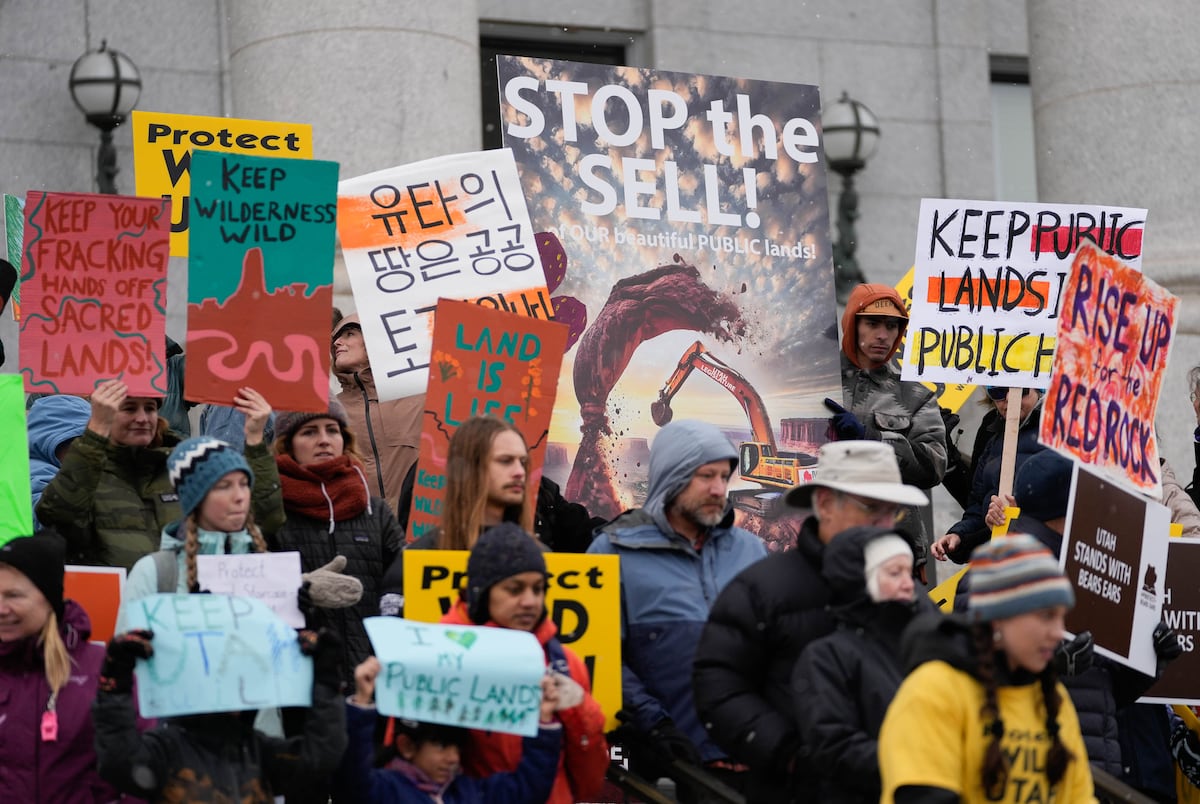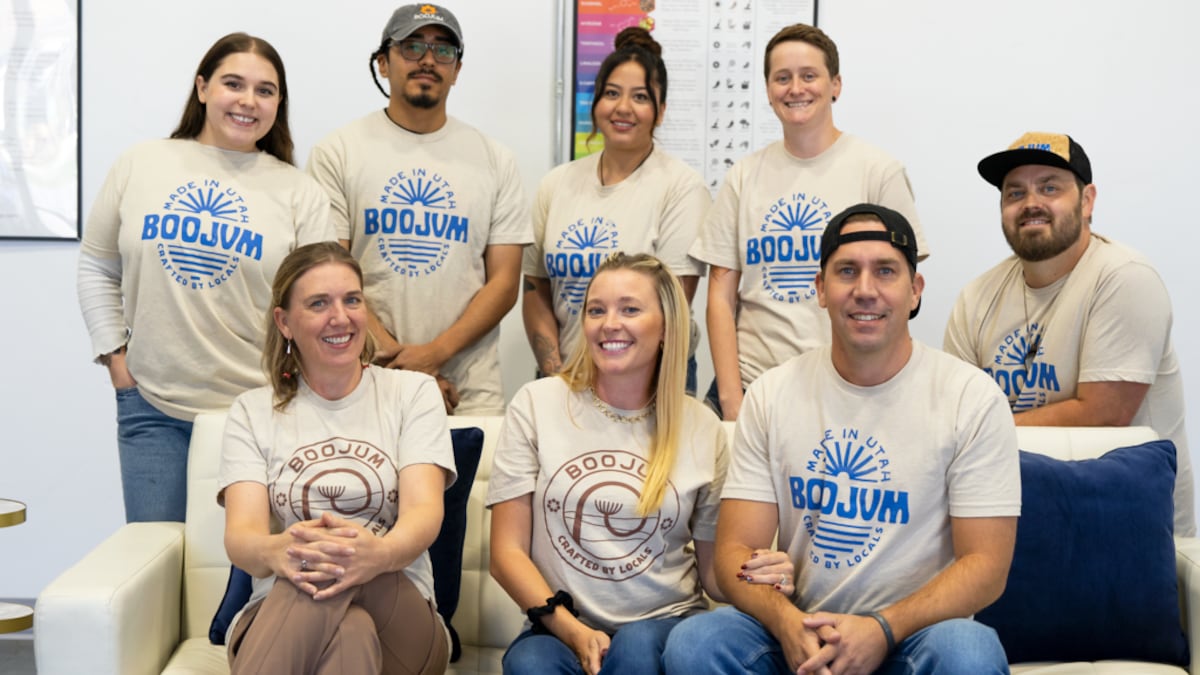Near the northwest boundary of the Uintah and Ouray Reservation, thousands of acres of land surround Tabby Mountain, rising 1,000 feet above nearby towns.
And though the mountain is named for a former Ute Tribe chief and rests within the boundaries of the more than 4.5 million-acre reservation where about half of the tribe’s membership now lives, it’s among millions of acres the tribal government doesn’t control.
Instead, the state owns it.
Utah’s school trust holdings within the reservation total more than 300,000 acres, according to the state’s Trust Lands Administration. State trust lands, on and off Indian reservations, make up millions of acres across the western United States and generate revenue for public schools, universities, jails, hospitals and other public institutions through the leasing of oil and gas, grazing, rights-of-way and timber.
The Utah Trust Lands Administration made $166.3 million for public institutions in 2023 from the 3.3 million surface acres and 4.9 million mineral acres it manages across the state.
That fiscal year, the trust paid out about $107 million of its cumulative earnings, according to an annual report, and nearly all of that money went to K-12 schools – institutions serving primarily non-Indigenous people.
Tribes rarely benefit from trust lands’ revenue, even when it comes from land within the reservations they were forced onto decades ago.
Rick Williams, founder and executive director of People of the Sacred Land, said trust lands are part of “the dark side of the history of Indian people and the United States.” The Indigenous-led nonprofit has been digging into the history of Native American lands and treaty rights in Colorado.
The truth about how Native people were forced from their homelands has been out there a long time, Williams said, but people have only now started talking about it. Williams said he was “as naive as anybody else” before he began researching.
Yet even as people discuss that dark history more, he said, very little has happened to address it.
“If you know you’ve done something wrong, what are you going to do to fix it? And that has never happened with the American Indian people,” he said.
A checkerboard of land ownership
The Utes’ Uintah and Ouray Reservation lies in northeastern Utah, about 150 miles east of Salt Lake City on U.S. Highway 40.
The Utes once lived in a gathering and hunting economy, but following conflicts with members of The Church of Jesus Christ of Latter-day Saints, the tribe moved to the dry Uinta Basin after signing the Treaty of Spanish Fork in 1865.
Later treaties created the Uintah and Ouray reservations for the tribe, which were later combined in what is now northeastern Utah. By 1933, the federal government had allotted 91% of the Utes’ reservation lands to white settlers, according to the Utah Division of Indian Affairs.
It is still the second-largest Indian reservation in the U.S., just behind the Navajo Nation, and covers more than 4.5 million acres.
But on closer look, the reservation is checkerboarded with multiple land claims on the reservation by individuals, corporations, and the government.
(Christopher Cherrington | The Salt Lake Tribune)
Altogether, the Ute Tribe oversees only a quarter of the reservation, according to a Grist investigation.
Data obtained through Grist’s “Misplaced Trust” investigation found that there are more than 500,000 acres of trust land within the Uintah and Ouray Reservation. A spokesperson for the Trust Lands Administration said the total is lower — about 359,000 acres, according to an emailed statement. The agency attributed the discrepancy to Grist double-counting acreage for parcels where the state owns the land and the mineral rights below it.
The state’s holdings on the reservation include 234,000 acres of full estate lands, 96,000 acres of mineral rights and 29,000 acres of surface-only ownership. Private owners and federal agencies also own large portions of the reservation.
Utes must lease land within their reservation from the state
Of the Indigenous nations in the U.S. that pay states to utilize lands within their own reservations, the Ute Tribe leases back the highest number of acres, based on Grist’s analysis.
The Ute Tribe’s cattle raising includes a lease with the state for nearly 47,000 acres of grazing inside reservation boundaries.
According to the email from the Trust Lands Administration, a grazing permit for a 640-acre plot runs around $300. Grist found that in one year, the Utes paid the state more than $25,000 to graze on school trust lands on the reservation. The Trust Lands Administration did not confirm or deny that figure when asked by The Salt Lake Tribune.
The Ute Tribe says on its website that the tribal government oversees about 1.3 million acres of federal trust land. That land differs from state trust land; the federal government holds the legal title, but the tribe has the right to use the land and receives the financial benefit. The tribe has built several businesses — including a supermarket, gas stations, a bowling alley, Uinta River Technologies and Ute Tribal Enterprises LLC — on federal trust land.
(Bethany Baker | The Salt Lake Tribune) A drilling rig is seen on tribal land within the Uintah and Ouray Reservation near Talmage on Thursday, Sept. 19, 2024.
Using publicly accessible lessee information with land use records, Grist and High Country News found that four other tribes also lease nearly 11,000 acres, combined, of state school trust land on their own reservations: the Hopi Tribe, Navajo Nation, Pueblo of Laguna and Zuni Tribe.
According to state records that the outlets examined, the vast majority of these tribally leased lands are used for agriculture and grazing, while 0.1% percent of tribally leased lands are used for utilities or right of way leases.
In addition to the Utes leasing for grazing, the Navajo lease a small portion of their reservation lands in Utah from the state for rights of way related to oil and gas operations. The state owns much smaller portions of the Navajo Nation and Ute Mountain Ute Tribe’s reservations.
Cris Stainbrook, past president of the Indian Land Tenure Foundation, told Grist that for tribes, the cost of leasing state trust lands on their reservations for grazing and agriculture is likely lower than what it would cost to fight for those lands in court. But, he added, those lands never should have been taken from tribes in the first place.
Dispute could undermine efforts to buy back land
The Ute Tribe, in recent years, has been trying to buy their ancestral homelands back from the state, federal government and private owners with the money they make from their own oil and gas drilling.
But in 2024, the state made it harder to do that in some cases after the tribe tried – and failed – to buy the 28,500-acre plot surrounding and including Tabby Mountain, named for late tribal chief Tabby-To-Kwanah.
The sale fell through – even though the tribe offered the initial highest bid for the land — due to pressure from state lawmakers who wanted the Utah Department of Natural Resources to buy it at a price they were willing to pay and make the mountain a public nature preserve and hunting haven.
State lawmakers then passed HB262 and changed the rules to allow the sale or lease of 5,000 or more acres of trust lands to the DNR — without advertising. The law exempts the Tabby Mountain parcel.
Then, the tribe called the legislation “clearly” retaliatory.
Rep. Casey Snider said that wasn’t the case. Snider, a Republican, told The Tribune in a recent interview that he sponsored the bill because of the 2021 sale of the Cinnamon Creek property in his Cache County district, more than 150 miles from Tabby Mountain.
He described the sale of that 8,000-acre property as “sort of a fire alarm sale of public property” with a limited opportunity for the state to secure it. Snider said he wanted to avoid that happening again and that HB262 enables open communication between TLA and DNR.
(Bethany Baker | The Salt Lake Tribune) Tabby Mountain can be seen near Fruitland on Thursday, Sept. 19, 2024.
The tribe declined to comment via an attorney who cited an ongoing lawsuit over the Tabby Mountain conflict. But tribal leadership has previously indicated concerns that the new rules will cut the tribe out.
Snider has a different concern: Keeping land that has been public open for Utahns to use whether or not they’re members of the Ute Tribe.
“I don’t think anybody is against having a conversation with the tribe. But I do think that, as a general rule, tribal acquisition does mean the exclusion of the broader public,” he said. “I understand that’s their prerogative, but tribal lands are not public lands.”
No land sales have triggered the state law since it took effect May 1, 2024, a spokesperson for the Trust Lands Administration said.
A call for ‘aggressively’ addressing grievances
Research has shown that tribal lands do better in tribal hands, according to the Project on Indigenous Governance and Development at Harvard Kennedy School.
“When Native nations make their own decisions about what development approaches to take, they consistently outperform external decision makers — on matters as diverse as governmental form, natural resource management, economic development, health care and social service provision,” it reads on the project’s home page.
But the country isn’t yet to a point where getting lands back into the hands of tribal governments to make those decisions is possible, experts said.
“It’s going to have to take the general public to get up in arms over it and say, ‘this is just morally wrong,’” Stainbrook, of the Indian Land Tenure Foundation, told Grist. “We haven’t gotten to that point where enough people are standing up and saying that.”
After Stainbrook retired late last year, the foundation recommended reaching out to Williams with People of the Sacred Land.
Williams has Oglala Lakota and Cheyenne heritage and, in addition to founding People of the Sacred Land, has been the head of the American Indian College Fund, the Student Academic Service Center and Minority Student Affairs at the University of Colorado and American Indian Upward Bound.
He said looking back on a history of wrongdoings can cause guilt, even though “nobody living today did any of these things.”
The honorable thing to do, he said, is “aggressively try to address those grievances in a way that creates opportunities in education or other areas” for the people who treaties displaced.
That includes building relationships to restore lands or developing comanagement agreements so tribes can start exercising some development rights, he said.
“Those are things that need to happen,” Williams said. “Otherwise, we will continue to be a country that denies Indian people a rightful place in their homeland.”
Editor’s note • This story is available to Salt Lake Tribune subscribers only. Thank you for supporting local journalism.










